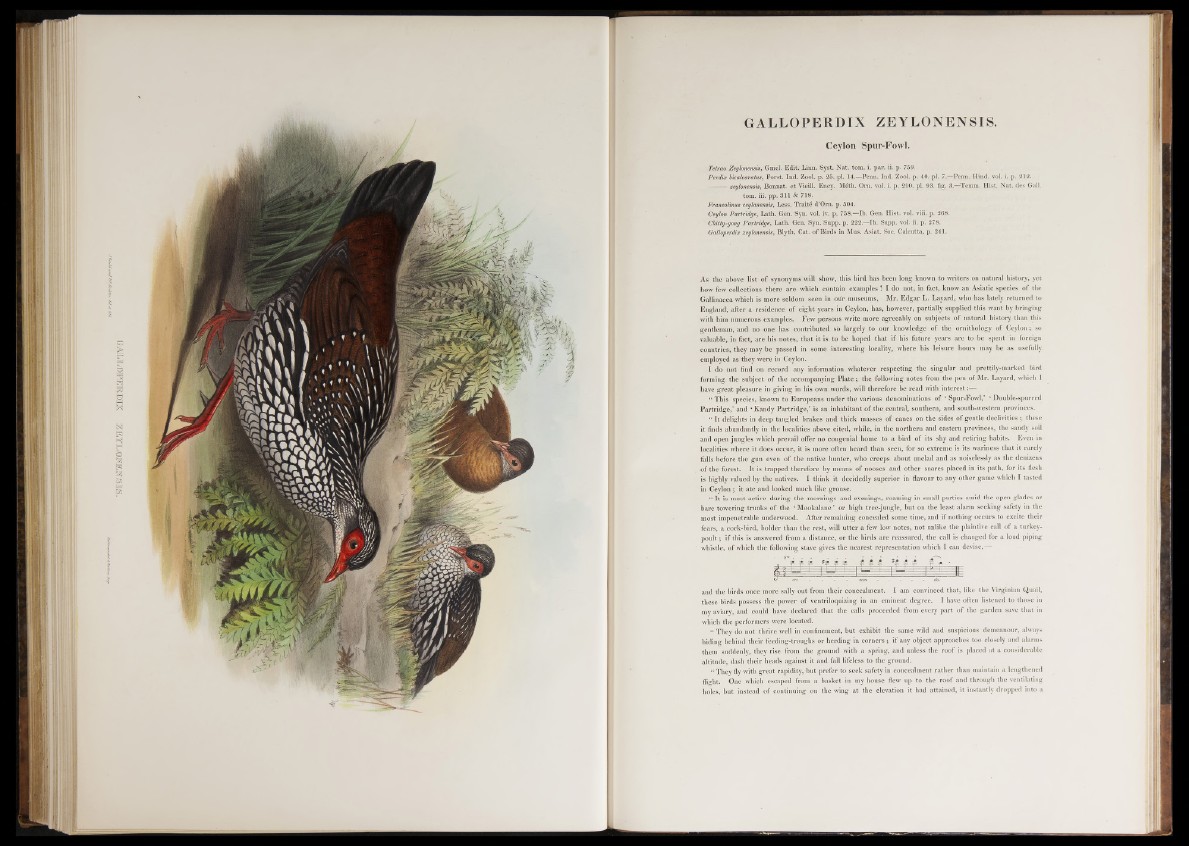
GALLOPERDIX ZEYLONENSIS.
Ceylon Spur-Fowl.
Tetrao Zeylonemis, Gmel- Edit. Linn. Syst. Nat. tom. i. par. ii. p. 759.
Perdix bicalcaratus, Forst. Ind. Zool. p. 25. pi. 14.—Penn. Ind. Zool. p. 40. pi. 7.—Penn. Hind. vol. i. p. 212.
— :— zeylonemis, Bonnat. et Vieill. Ency. Méth. Orn. vol. i. p. 210. pi. 93. fig. 3.—Temm. Hist. Nat. des Gall.
tom. iii. pp. 311 & 718.
Francolinus ceylanemis, Less. Traité d’Om. p. 504.
Ceylon Partridge, Lath. Gen. Syn. vol. iv. p. 7 5 8—lb. Gen. Hist. vol. viii. p. 268.
Chitty-gong Partridge, Lath. Gen. Syn. Supp. p. 222.—Ib. Supp. vol. ii. p. 278.
Galloper dix zeylonemis, Blyth, Cat. o f Birds in Mus. Asiat. Soc. Calcutta, p. 241.
As the above list of synonyms will show, this bird has been long known to writers on natural history, yet
how few collections there are which contain examples ! I do not, in fact, know an Asiatic species of the
Gallinácea which is more seldom seen in oiir museums. Mr. Edgar L. Layard, who has lately returned to
England, after a residence of eight years in Ceylon, has, however, partially supplied this want by bringing
with him numerous examples. Few persons write more agreeably on subjects of natural history than this
gentleman, and no one has contributed so largely to our knowledge of thé ornithology of Ceylon; so
valuable, in fact, are his notes, that it is to be hoped that if his future years are to be spent in foreign
countries, they may be passed in some interesting locality, where his leisure hours may be as usefully
employed as they were in Ceylon.
I do not find on record any information whatever respecting the singular and prettily-marked bird
forming the subject of the accompanying P la te; the following notes from the pen o f Mr. Layard, which I
have great pleasure in giving in his own words, will therefore be read with interest:—
“ This species, known to Europeans under the various denominations of ‘ Spur-Fow],’ ‘ Double-spurred
Partridge,’ and ‘Kandy Partridge,’ is an inhabitant of the central, southern, and south-western provinces.
“ It delights in deep tangled brakes and thick masses o f canes on the sides of gentle declivities; these
it finds abundantly in the localities above cited, while, in the northern and eastern provinces, the sandy soil
and open jungles which prevail offer no congenial home to a bird of its shy and retiring habits. Even in
localities where it does occur, it is more often heard than seen, for so extreme is its wariness that it rarely
falls before the gun even of the native hunter, who creeps about unclad and as noiselessly as the denizens
of the forest. It is trapped therefore by means of nooses and other snares placed in its path, for its flesh
is highly valued by the natives. I think it decidedly superior in flavour to any other game which I tasted
in Ceylon ; it ate and looked much like grouse.
“ It is most active during the mornings and evenings, roaming in small parties amid the open glades or
bare towering trunks of the ‘ Mookalane’ or high tree-jungle, but on the least alarm seeking safety in the
most impenetrable underwood. After remaining concealed some time, and if nothing occurs to excite their
fears, a cock-bird, bolder than the rest, will utter a few low notes, not unlike the plaintive call of a turkey-
poult ; if this is answered from a distance, or the birds are reassured, the call is changed for a loud piping
whistle, of which the following stave gives the nearest representation which I can devise,—
and the birds once more sally out from their concealment. I am convinced that, like the Virginian Quail,
these birds possess the power of ventriloquizing in an eminent degree. I have often listened to those in
my aviary, and could have declared that the calls proceeded from every part of the garden save that in
which the performers were located.
“ They do not thrive well in confinement, but exhibit the same wild and suspicious demeanour, always
hiding behind their feeding-troughs or herding in corners ; if any object approaches too closely and alarms
them suddenly, they rise from the ground with a spring, and unless the roof is placed at a considerable
altitude, dash their heads against it and fall lifeless to the ground.
“ They fly with great rapidity, but prefer to seek safety in concealment rather than maintain a lengthened
flight. One which escaped from a basket in my house flew up to the roof and through the ventilating
holes, but instead of continuing on the wing at the elevation it had attained, it instantly dropped into a